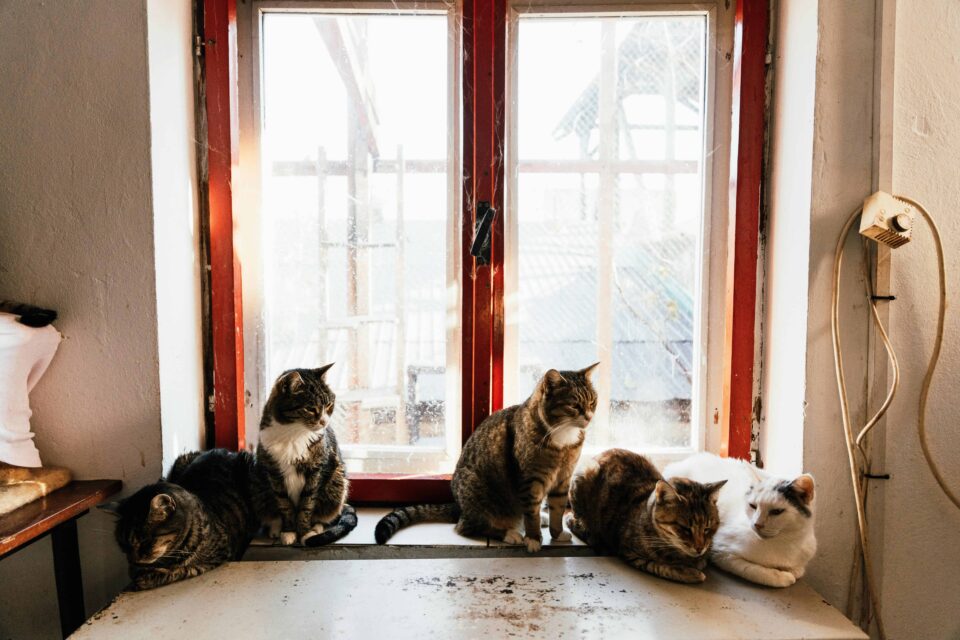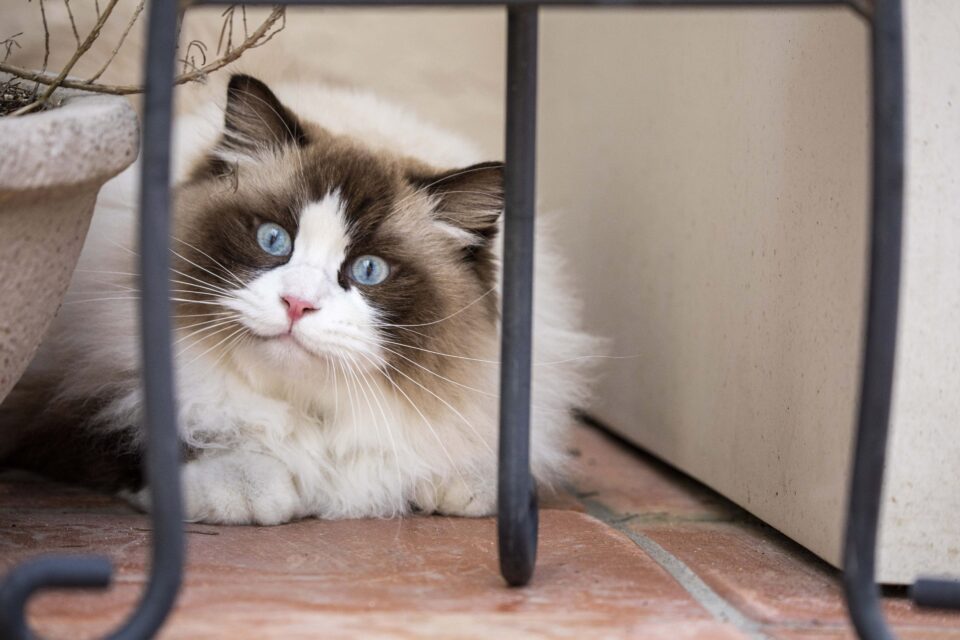How Cold is Too Cold for Cats?
Understanding your cat’s comfort zones is crucial for their happiness and health. Cats prefer warmth but may not always recognize when it’s too cold. Understanding these zones can help keep them cozy.
Key Takeaways
- Cats are sensitive to cold due to their desert origins and higher body temperature.
- Older, younger, or sick cats feel the cold more intensely than healthy adult cats.
- When the temperature drops below 45°F, it’s best to keep cats indoors.
- Signs of cold in cats include curling up tightly, shivering, and lethargy.
- Providing warm beds and draft-free zones helps keep indoor cats comfortable.
Understanding How Cats Perceive Cold
The Natural Insulation of a Cat’s Coat
Cats are adept at handling cold due to their natural insulation, but they can still feel the chill, especially when outside. They instinctively seek warmth, curling up in sunny spots or cozy corners.
Why Some Cats Feel Colder Than Others
Not all cats possess the same level of warmth. Several factors can make some felines feel colder than others:
- Breed Differences: Cats like the Maine Coon have thick, dense fur that keeps them warmer for longer. Conversely, cats with little to no hair, such as the Sphynx, are more vulnerable to the cold.
- Health and Weight: Skinny cats or those with health issues might struggle more with cold temperatures.
- Age Matters: Kittens and senior cats are more vulnerable to the cold as they can’t regulate their body temperature as effectively.
The Role of Body Size and Age in Cold Sensitivity
Cats’ body size and age significantly influence their cold perception. Smaller cats lose body heat faster, while older cats struggle with warmth due to slower metabolism and less body fat. Monitor their behavior and provide warm spots during colder months.
Recognizing Signs of Cold in Cats
Behavioral Indicators of a Chilly Cat
Cats are masters at hiding discomfort, but there are subtle signs that can tell you when they’re feeling the chill. Watch for changes in their usual behavior. If your cat is suddenly snuggling up to heaters or curling into a tight ball more often, they might be trying to stay warm. Pay attention to their sleeping spots—if they’re avoiding their usual places and opting for warmer spots, it’s a clue they’re feeling cold.
- Seeking out warm places like radiators or sunny spots
- Curling up tighter than usual
- Sleeping more than usual
Physical Symptoms of Cold Stress
Your cat’s body can also give you hints about their temperature comfort. Check their ears, paws, and tail. If these extremities feel cold to the touch, your feline friend might be too chilly. Shivering is another clear sign. Also, a cat that is cold may become less active and more lethargic.
- Cold ears, paws, and tail
- Shivering
- Lethargy and reduced activity
When Cold Turns to Hypothermia
Hypothermia in cats is serious and can be life-threatening. It occurs when their body temperature drops too low. Signs of mild hypothermia include weakness, shivering, and a lack of alertness. If not addressed, it can escalate to severe hypothermia, characterized by extreme lethargy, slow heart rate, and even unconsciousness.
- Mild Hypothermia: Weakness, shivering, and cold extremities
- Severe Hypothermia: Lethargy, slow heart rate, and unconsciousness
Recognizing the signs of cold in your cat is crucial. Always act quickly to warm them up before it progresses to hypothermia.
Related: How to Tell if a Cat Is Depressed
Ideal Indoor Temperatures for Cats
Setting the Thermostat for Comfort
Similar to humans, cats have specific comfort zones when it comes to room temperature. Most cats prefer an ambient temperature between 77–86°F (25–30°C). This range ensures that your feline friend is neither too hot nor too cold, providing a cozy environment for them to relax and play.
Creating Warm Spaces in Your Home
Even with the thermostat set just right, cats love having warm spots to curl up in. Consider setting up a few of these cozy nooks around your home:
- Sunny Windowsills: cats adore basking in the sun, so ensure they have access to sunny spots.
- Heated beds: These are perfect for older cats or those with thin coats.
- Blanket-Filled Corners: A pile of soft blankets in a quiet corner can be a perfect retreat.
The Importance of Draft-Free Zones
Drafts can make any room feel chilly, and your cat will notice. Ensure that their favorite lounging areas are free from drafts.
- Seal Windows and Doors: Use weather stripping to keep the cold air out.
- Close Off Unused Rooms: This helps maintain a stable temperature in the areas your cat frequents.
- Elevate Cat Beds: Keeping beds off the floor can reduce exposure to cold drafts.
Keeping your cat’s environment warm and comfortable is essential for their well-being. A content cat is a happy cat, and maintaining the right indoor temperature is a big part of that.
Outdoor Safety: When It’s Too Cold for Cats
Understanding Temperature Thresholds
Cats are natural explorers, but when it comes to cold weather, it’s important to know when to say no. Typically, temperatures below 45 degrees Fahrenheit are too cold for most cats. Even if your cat seems eager to venture outside, it’s better to keep them indoors when it’s this chilly. Prolonged exposure to cold can lead to serious issues like hypothermia or frostbite.
Providing Outdoor Shelters
If your cat insists on spending time outside, providing a safe and warm shelter is essential. Here’s a simple checklist to ensure your cat’s outdoor shelter is cozy:
- Insulate the shelter with straw or blankets.
- Ensure the entrance is small to keep out drafts.
- Elevate the shelter off the ground to prevent moisture from seeping in.
The Risks of Prolonged Exposure
Cats left outside in freezing conditions face numerous risks. Frostbite can affect their ears, tails, and paws, leading to painful injuries. Frostbite in pets is a serious concern, and if your cat shows signs like discoloration or swelling, immediate action is necessary. Move them to a warm place and consider using a specialized ointment to alleviate discomfort. Remember, prevention is key—limit their time outside and monitor their behavior closely.
Keeping your cat warm isn’t just about comfort—it’s about ensuring their safety and well-being during the colder months.
Helping Your Cat Stay Warm and Cozy
Choosing the Right Cat Apparel
When it comes to keeping your cat warm, a cozy sweater can work wonders. Some cats, especially those with thin coats or older cats, might feel the chill even indoors. A snug-fitting sweater can make all the difference. Look for materials that are soft and non-restrictive, like cotton or fleece. Just be sure your cat is comfortable and can move freely.
The Benefits of Heated Beds
Heated beds provide a consistent source of warmth, particularly comforting during the cold months. They come in various styles, from self-warming mats to plug-in versions. Most cats love the gentle heat, and it can be beneficial for older cats with arthritis. Place the bed in your cat’s favorite spot and watch them bask in the warmth.
DIY Warmth Solutions for Cats
DIY solutions for keeping your cat cozy include creating a no-sew fleece blanket or filling a sock with rice for a heating pad. Test the temperature before giving it to your cat, as keeping them warm is essential for their safety.
When winter sets in, keeping cats indoors during winter becomes even more crucial to protect them from the elements. By providing the right gear and cozy spots, you’re ensuring your cat stays happy and healthy all season long.
Related: How to Get Rid of Fleas on Cats
Special Considerations for Vulnerable Cats
Caring for Kittens in Cold Weather
Despite their playful nature, kittens require special attention during cold weather due to their inability to regulate their body temperature. Here are some ways you can assist:
- Provide a cozy bed with plenty of blankets.
- Keep them indoors as much as possible.
- Consider using a heating pad designed for pets.
Supporting Senior Cats in Winter
Older cats often feel the cold more due to slower metabolism and less body fat. They might appreciate a little extra warmth:
- Ensure they have access to warm, draft-free areas.
- Use heated cat beds to help soothe any arthritic joints.
- Monitor their behavior for signs of discomfort.
Managing Health Conditions in the Cold
Cats with health issues like arthritis or respiratory problems can struggle more in the cold. Here’s what you can do:
- Keep their living area warm and dry.
- Consider clothing for cats that tolerate it, like a soft sweater.
- Regular vet check-ups to manage their conditions effectively.
Remember, even the heartiest of cats need a little help staying cozy when the temperature drops. It’s all about making them comfortable and safe.
When caring for vulnerable cats, it’s important to pay special attention to their unique needs. These cats may require extra love and support to thrive. If you’re looking for the best products to help your furry friend, visit our website today!
Conclusion
Cats, like humans, can feel the chill when temperatures drop. They have their limits, and keeping them warm is crucial for their health. When mercury drops, ensure your cat has a warm spot to snuggle up in, as a happy cat is a warm cat.
~Veterinarian Recommended